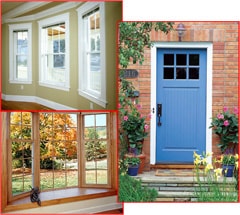Questions and Answers
We have all felt the effects that recent increases in energy and gas costs have created in our home energy bills. Making sure that your windows and doors are energy-efficient can have a tremendous impact on your monthly expenditure. Windows can make up anywhere from 10 to 50% of your home’s exterior walls and have an enormous potential for heat loss, unless you choose to install energy efficient products in your home.
Many homeowners don’t realize the significant loss in energy (heat and air conditioning) that their windows cause for them over the course of a year. Energy Star estimates that the average homeowner can save up to 25% on their monthly energy bill by installing Energy Star rated replacement windows in their home.
Replacing your windows or doors can help you solve any of the following problems, if you choose the right product 
- Energy loss
- Condensation
- Rotting frames or trim
- Warping or twisting
- Poor security
- Difficult to open and close
- Noise
- Maintenance
Contact our office today to set-up a an estimate and find out how much you could be saving on your energy bill! Our Project Consultant will complete a brief energy assessment with you, to determine how you can reduce the amount of energy loss from your home.
Return on Investment
Another benefit to replacement of windows is the added value to your home. Did you know that you can recoup an estimated 81% of your replacement of mid or high grade windows? According to Remodeler Magazine, homeowners can recoup a significant portion of their window replacement when reselling their home. This, combined with the savings in energy efficient, makes the replacement of windows one of the smartest investments a homeowner can make!
Vinyl Windows
It Is Just A Vinyl Replacement Window Right? Are they not all basically the same? Why are some vinyl windows more expensive than others? What’s up with the white color variation, is not white, white?
You are awake, but you have crossed over into the vinyl window dimension. The only experience I can compare it with is a trip through a house of mirrors at a county fair. You must proceed cautiously and slowly through this difficult maze.
Let’s start with your certification concern. The American National Standards Institute, Inc.(ANSI) and the American Architectural Manufacturers Association(AAMA) joined together to produce voluntary specifications for vinyl window construction. These specifications are very technical and deal with issues concerning durability and safety.
The certification program is very tough. Windows must be constructed using certified components, such as high quality vinyl, glass, and weatherstripping. Windows are tested randomly and periodically for a manufacturer to maintain certification status. Make sure the windows you purchase are constructed using the most recent guidelines, ANSI/AAMA 101-93. A sticker on the window frame should contain language indicating that the windows are approved.
Construction of vinyl windows is very important. There are two basic methods: mechanical connections and fully welded construction. Both types of construction can pass the rigid testing as outlined by the ANSI/ AAMA specifications. Mechanically connected windows are assembled by using screws, brackets, and caulk at the corners of the windows and frames. Connections can loosen or fail during the trip from the factory to your home. Fully welded construction takes advantage of the chemistry of vinyl. After the sections of the frame and window are cut, the mitered corners are heated. Once assembled and cooled, the two pieces of vinyl actually become one.
Heat (from direct sunlight), however, can cause big problems with some vinyl windows. Very close to 160 degrees F, most vinyls begin to loose some of their rigidity. Stress can cause frames to sag and distort. If you live in the South or Southwest, windows that face west can take a beating in the late afternoon. It is absolutely essential that you purchase high quality vinyl if you feel your windows will be exposed to this type of sunlight.
Quality windows are often constructed using frames which have many separate chambers. The cooler chambers which are away from direct sunlight help to hold the heated portions of the vinyl in shape. Steel inserts can also be used in larger windows. However, be sure the steel is encased in an inner chamber that is then welded shut. If not, your vinyl windows may actually start to rust!
The large number of chambers also provides another benefit. When mitered for assembly, the cut edge of a frame exposes the edges of the chambers. These are the parts which are heated and welded together. The more edges you have, the stronger the weld will be. In fact, manufacturers can tell you the square inch area of welded vinyl at each corner. Purchase a window with the highest square inch area.
The color differences you noticed are real. Some vinyls used in windows will change color when exposed to sunlight. Almost all vinyls will eventually begin to yellow. However, some will yellow much quicker than others. Some, not all, manufacturers tint their vinyl blue to delay this process. There are high quality blue vinyl windows, however. If you want these for your house, be sure to look for the ANSI/AAMA label.
Quality vinyl windows contain high amounts of titanium dioxide. Windows which have high amounts of this pigmentation chemical are almost always pure white. High quality vinyl also contains an organic form of the metal tin which also helps to stop the yellowing process. If the people in the window showroom act surprised about these things, keep shopping! ~ Ask the Builder
Over 50 percent of windows purchased today are vinyl windows. Choosing a superior vinyl window can be difficult if you don’t know what to look for. It can prove even more frustrating if you purchase and install your vinyl windows only to find that they’re poor quality, uneven and already fading in appearance. You might also face the realization that a bigger name is not always better and price is only one of several considerations.
There’s more to choosing and installing vinyl windows than meet the eye. What’s inside a window is more important than what’s on the outside since the internal structure determines a window’s longevity.
According to Ernie DeBacco of Visions Windows and Doors, a thicker window is better. “In general, thicker internal parts result in longer-lasting quality, greater appeal and little to no maintenance.”
As a homeowner shopping for the best vinyl window, consider these factors in purchasing and making additional upgrades:
- Vinyl: Look at a cutaway view of the window to identify the quality of the vinyl and the thickness of the window’s components. A thicker vinyl ensures rigidity and more overall resistance to weather damage.
- Jambs: The vertical members of the window frame, thicker jambs provide better overall performance of the operating parts of the window called the “sash.” Building-grade windows have jambs from 2-7/16 to 3 inches thick, while premium grade windows offer 3-1/4 inch jambs. Visions’ windows and patio doors, for example, have 3-1/4 inch jambs.
- Fusion-welded frames and sash: Maintaining a window’s square form helps ensure proper installation, in addition to creating a sharp look. Fusion-welded frames and sash can make a big difference here; windows that utilize a four-point welding system for the head, sill and two side jambs, and for the sash are sturdier and less likely to crack or break.
- Chambers: These internal cavities within the frames and sash trap air, which insulates against heat and cold transfer through the window. Thick, multi-chambered frames and sash greatly improve structural performance by reducing the amount of seasonal expansion and contraction. Building-grade vinyl windows generally have two to three internal chambers whereas premium grades have five, six or seven chambers offering superior energy efficiency.
- Sloped sill: It’s not the thickness that matters here; instead, consider the degree of the slope of the window’s sill. Pockets seen on some vinyl brands will not keep water from collecting inside and outside of the window. A higher slope will allow for rainwater to hit the sash and flow downward, away from the window. This prevents water spots on the glass, and wear and tear on the vinyl.
- Spacers: The material used to join two pieces of glass together to form a dual-pane (or insulated) window — a spacer’s material composition will affect air transfer. Metal spacers provide either a stuffy or chilly atmosphere depending on the season. Non-metallic spacers minimize the transfer of heat or cold through the window and minimize condensation on the windows, which is often caused by higher humidity levels in a home.
- High performance glass: Vinyl windows, in general, are more energy efficient than wood windows. High performance glass gives homeowners even greater latitude to keep energy costs down. Visions Windows & Doors, as an example, offers Zo-e-shield, a glazing system that uses advanced technology to reduce the amount of heat or cold moving through a window. It also provides some of the best protection you can find against fading of home interiors caused by the sun’s rays.
More options are becoming available in the vinyl window market. A window made up of thicker jambs, more internal chambers, and fusion-welded frames and sash ensures durability and performance for all seasons. High performance glass, non-metallic spacers and sloped sills will contribute to improved comfort and convenience in the home. If you can’t remember all that, just remember, you can’t judge a window by its cover.
You can see a few of our adventures with window and door replacements or installation here: Window and Door Replacement
